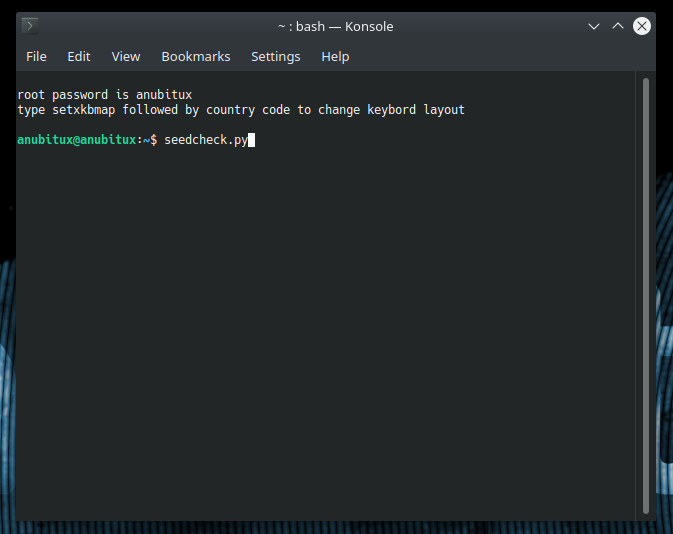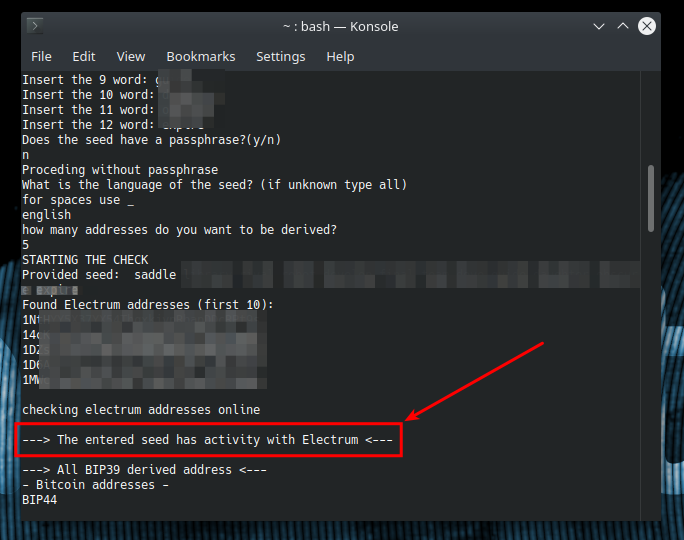Find out how a seed was used with AnuBitux

There could be many situations in which we need to check how a seed was used: for example, we could have a lot of old seeds and did not take note of how they were used, or we could be a consultant helping others recover access to their funds. It can become very frustrating and time-consuming to check the seeds with many different tools, to find out the right one.
In this case, AnuBitux could help us with seedcheck.py, a tool developed by its team.
How to use it
To run seedcheck.py, simply type it in AnuBitux's terminal.

Then the only thing we have to do is answer the prompted questions. First of all, the tool asks us if we want to check online if the addresses derived with the seed we are looking about had some activity. This information is used to determine with what currency the seed was used and which one could be the correct derivation path.

If we are worried about our privacy, we can ask no to this question and the tool will work completely offline. We could also start the Anonymous proxy, clicking on the provided desktop shortcut and all our network traffic will be routed through TOR.
Then we have to provide the seed's length, without counting an eventual passphrase as part of it. Don't worry, the tool will ask later for it. Now, we can insert the words composing our seed.

We can now provide a passphrase, if the seed has one. Then we can specify the language of the seed, to check it with the correct wordlists.

If we are not sure about it, we can simply answer "all" and the tool will determinate the language itself.
The accepted answers are:
- english
- italian
- french
- spanish
- portuguese
- czech
- chinese_simplified
- chinese_traditional
- japanese
- korean
- russian
- esperanto
- lojban
Please, provide the languages as they are written in the above list, or the tool could encounter running issues.
Now, we can ask how many addresses we want to derive for any supported derivation path. It impacts on the ouput of the tool and on the amount of the check that the tool will do online.

The more addresses we derive, the more possibilities we have to find used ones. The tool will suggest us a maximum of 15 addresses, to avoid overloading the APIs queried during the check, but if we need we can force it to derive as many addresses as we want.
Now the tool starts its magic, checking if the seed was used with an Electrum wallet, or if it is a BIP39 seed used with many different derivation paths to derive Bitcoin, Ethereum, Litecoin, Dash or ZCash addresses. It is also going to check if the seed was used with Samourai's Whirlpool, deriving premix and postmix addresses. The tool also checks if the provided seed is compatible with Monero wallets (like MyMonero, Feather wallet or Monero wallet).

As we can see, the tool was able to determinate that the tool was used with Electrum, because the addresses derived with Electrum's algorithms had some activity.
The tool also find out that the seed could have been derived from a BIP39 wordlist, and checks it with many different coins.

But, in this case, the tool did not find any valid derivation path because no one of the derived addesses was involved in any transaction.
The tool also works with Monero seeds. Let's check how it works in this case.

As we can see, the tool was able to find out that the tool is compatible with Feather wallet. To check if it had some activity, simply open Feather wallet, which is also available in the AnuBitux wallets menu, and use it to restore a wallet providing this seed.
Final thoughts
Of course, this tool does not do a full check, because the seed could have been used with other coins or with custom derivation paths or with some other proprietary algorithm, but it is a great help to rapidly do a lot of checks. If it gives us a positive result, we can be sure that the seed was used but, if it gives us a negative result, to be completely sure the seed was never used we should try it with as many tools as we can.

